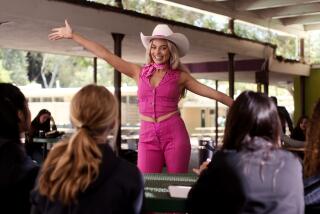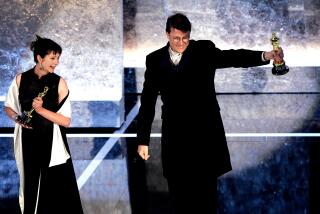A passion to convey a director’s vision
- Share via
There have been endless debates about “The Passion of the Christ,” which was shut out of contention for Oscar’s biggest honors. But one striking aspect of the film has stood apart from controversy: veteran cinematographer Caleb Deschanel’s work on “Passion’s” look and feel, which earns him his fifth Oscar nod and one of the three nominations the film has received.
Deschanel has worked on such films as “Being There,” “The Black Stallion,” “The Right Stuff,” and “The Natural.” But it was clear from the start that “The Passion,” which earned more than $370 million at the domestic box office and found itself on the front line of election year “culture wars,” would demand a different sort of artistry and depth.
To begin with, Deschanel -- who was raised a Quaker -- came to the story of the final hours of Jesus Christ with little background knowledge.
“It’s embarrassing to say,” Deschanel said, “but honestly, I didn’t know the story. And I found it really moving and thought it was really powerful emotionally. To me it was this wonderful pacifist message ... the idea of resisting revenge and forgiving the people who are attacking you.”
Then he learned that Mel Gibson -- the director, co-screenwriter and producer of “The Passion” -- wanted to tell the story in ancient languages: “When Mel first came to me and said, ‘We’re gonna do it in Aramaic and Latin,’ it was just so far-out an idea, I thought, ‘Wow, this is great, I just have to do this, this is really going to be something.’ ”
Deschanel, who had previously worked with Gibson on “The Patriot,” said that as the two men began talking about “The Passion,” both agreed on an inspiration: the classically burnished naturalism of the Italian Baroque painter Caravaggio. Deschanel also planned to draw on extensive research he had done into depictions of the events of the movie from all corners of art history, from the Renaissance to the modern day, from Giotto to Dali.
In the end, the research became what Deschanel refers to as “a catalog of ideas,” and he notes “there isn’t any specific shot in the movie that references any specific painting. They were more inspirational.” As well, though Deschanel looked at a number of films previously shot in the same locations, most notably Pier Paolo Pasolini’s “The Gospel According to St. Matthew,” he consciously avoided modeling the look of any previous biblical-themed films.
From its moody, nighttime opening to its tragic, sunlit denouement, for all its much-noted bloodshed and violence “The Passion of the Christ” is a film that contains many looks and visual schemes within its overall framework, which Deschanel says is as intended.
“I’ve always felt films are like symphonies,” he said, “in that you have different movements in them, and there’s a visual progression.”
Continuing to describe the motivations for the look of the film, he adds, “We tried to find ways visually to make you feel like you were really there, but there in the sense of a story that’s been passed down for so long that it has both a reality and a super-reality about it as well.”
These words are echoed by Gibson himself when, speaking by phone, he said, “If you’re going to do something that’s in-your-face and brutal, it was important to me that it had to be lyrical. Even in its intensity and brutality, it had to have a beauty to it.”
In conversation regarding his own work on the film, Deschanel repeatedly notes the contributions of production designer Francesco Frigeri and set decorator Carlo Gervasi, as well as the performances of the actors.
It is this same self-effacing modesty that Gibson notes when he adds, “He gave me exactly what we agreed it would be. I said to him one day, in an astounded manner, ‘It’s like a moving Caravaggio,’ and he said, ‘That’s what you wanted, isn’t it?’ ”
Although “The Passion” received mixed reviews in some quarters, Deschanel’s work earned widespread praise. “Caleb Deschanel paints with an artist’s eyes,” wrote critic Roger Ebert.
Not bad for someone who jokes that in some circles he’s far better known as the father of up-and-coming actresses Emily and Zooey Deschanel than for his work behind the camera.
Deschanel, 60, said he knew all along that “The Passion of the Christ” was a special film. (It also earned Oscar nominations for makeup and score.) But he admits being surprised by its success: “I had no idea, certainly no expectations, that a lot of people would see it.”



